When connecting two different in the texture and texture of materials, it is necessary to somehow make a place for their connection. In this article we will discuss how beautiful to docile laminate and tiles. Methods are different, as well as results.
Where maybe the junction and how it is better to arrange it
In a modern house or apartment, different floor coverings are used. In places of their compound, height differences are often formed - due to different coating thickness. To make such a transition beautifully and reliably can only know what to do. Most often you have to keep tiles and laminate. These are the two most popular type of flooring for premises of various purposes. The junction of tiles and laminate at the place of position is in two places:
- Under the door where the coatings of two rooms are combined. It is easier and more efficient to separate the joint with a small special thoring.

Two types of places of connection of the tile and laminate - with a boost and without
- In the open space, where the transition tile / laminate emphasizes the zoning of the room. In this case, a more natural transition will be, if you make a joint without additional inserts.
As you already understood, there are two ways to make a junction of laminate and tiles - with a damage and without it. The first requires high quality trimming tiles, the same gap between two materials all over the seam. Only in this case it turns out a decent result. The second is simpler in performance, does not require special accuracy in the trimming of the material and special skills when performing. But it looks somewhat "rustic."
Methods for docking without a birth
When docking the tile and laminate without a clad, it is predefined to solve the problem of the height drop: due to the layer of glue tile may be higher. Only after that you can proceed to work. Even, the connection site will look good if it is carefully processed, the gap will be smooth.
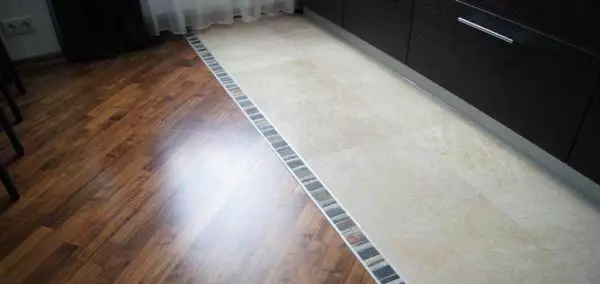
This is how neatly you can make a tile connection with laminate.
If two different materials are jammed - ceramics and laminate - it is impossible to place them close to each other without a gap. When the temperature difference or humidity drops, they can increase in size (more than that "suffers" laminate). The presence of a gap prevents the problem - it makes it possible to change it in size without prejudice to the integrity of the coating. When docking the laminate and tiles without a clad, this gap is filled with a suitable elastic material.
Whatever material is not used for sealing, the edge of the laminate, it is adjacent to it, be sure to process the protective composition, which prevents moisture absorption. Most often a sealant is used for this. Better - silicone, which, after drying, does not lose elasticity and does not shine over time.
Cork compensator
Between the tile and laminate you can lay the cork compensator. This is a thin strip of the plug, which on one side is painted and covered with a layer of protective varnish or finished with a layer of veneer. The second option is greater than the wood surface, you can pick up a color, very similar to your floor-coated. But it is used more often for the junction of the parquet - it costs a lot.
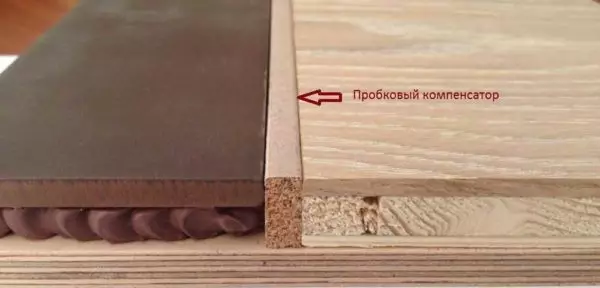
This looks like a laminate butt and tiles with a cork compensator.
Dimensions
In addition, that in the "face" of a cork compensator is frozen by different materials, it can be of different shapes: from the chamfer different types or without. In addition, the sizes can be different:
- length:
- Standard - 900 mm,
- under the order - from 1200 mm to 3000 mm;
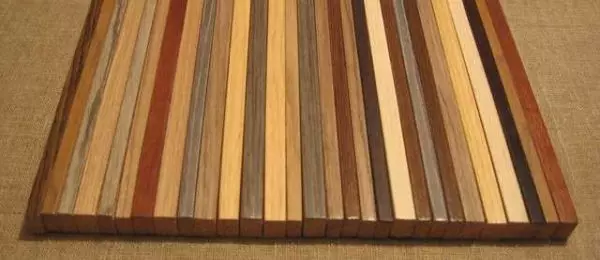
Color is selected under one of the materials
- width - 7 mm and 10 mm;
- Height - 15 mm, 18 mm, 20 mm, 22 mm.
Cork compensator of standard length is good only if the junction is under the door. Then its length is enough. In other situations or you have to splict, or order.
Installation
Install the cork compensator at the junction of the tile and laminate when laying the floor covering. When one species is already laid, and the second will only fit. First of all, if you need to cut the height of the cork - you can not always pick up the perfect option. Therefore, neatly, sharp knife cut off the surplus.
More preparatory work - bringing the laid edge. Once again we remind you, it should be smooth and well-processed. Most often, the edge is grinding sandpaper, aligning the traces of cutting.
Mounted cork compensator for glue, preferably - for wood. Previous installation location is well cleaned and degreased. Next, the process is:
- Apply close to the already laid material of the gloss. It is possible - zigzag, can be parallel stripes.
- We lake the plug, slightly pressing it to the already laid material.
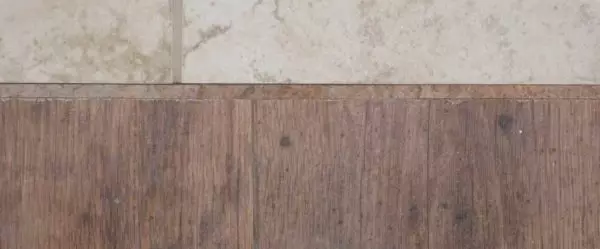
So looks sown near
- Fill the cork and apply a sealant.
- Cress the plug back. The squeezed sealant is removed with a sponge moistened in the water, then rub the dry rag. His traces should not be visible at all.
- Next, put the second material close to the plug. If it is a laminate, it is absorbed by silicone in obligatory. When laying the tile, it is also desirable to do, but the seam can be filled with glue, which is also good, although not so beautiful.
If you do everything correctly, it turns out a neat, not striking seam. Well, so you can make straight and curvilinear joints.
Grout for seams
If the materials are already laid, the junction of laminate and tiles can be or arranged by a hole, or fill the tile grout. We will talk about the thresholds later, but now we will discuss how to use the grout.
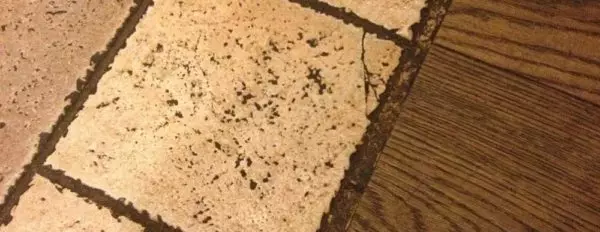
Grout for seams is used in the same color as for interputric seams
The edges of the laminate should be molded with silicone. They can also fill the junction for about 2/3. When silicone dries out, the remaining space is filled with a diluted grout for seams, align it and wait until it dry.
A simple and effective way. But only if the edges are treated qualitatively. For greater color stability and easier care, the seam is better covered with colorless varnish.
Cork sealant
Another junction of laminate and tiles can be sealed using cork sealant. He himself is a sealant, so this is the only option in which the slice of laminate does not need to be protected from moisture. Another plus - the dried composition has a cork tree color - light brown. If it is suitable for you, you will not have to take care of his painting.
Cork sealant is a mixture of crumb of cork cork and a water-based binder. Without dyes after drying, there is a plug color - light brown. There are painted palettes painted in the main colors. Available in polyethylene tubes, it can be applied using a closed type gun (with a capacity) or a spatula. Can be used to fill seams in floor coatings.
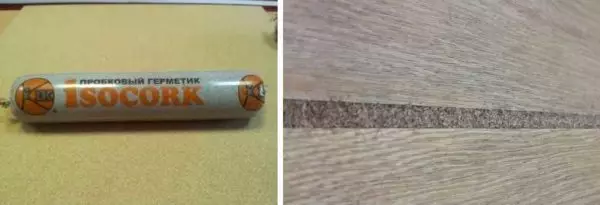
Cork sealant and the result of its use
When using this composition, you will most likely have to use the spatula. Therefore, on both Side ILO SHA stick a raner tape. Seam is cleansed, remove dust. You can work at temperatures above + 5 ° C.
Seared tiles and laminate with cork sealant simply:
- Open tube. The composition is ready for use in it, but for convenience it can be pouring into a container with wide edges. You can also try to make a small hole and fill it through it.
- Fill the seam (with a spatula or immediately from the tube - as it turns out).
- Sut off the surplus, align the surface, spending the spatula from the edge to the edge of the seam.
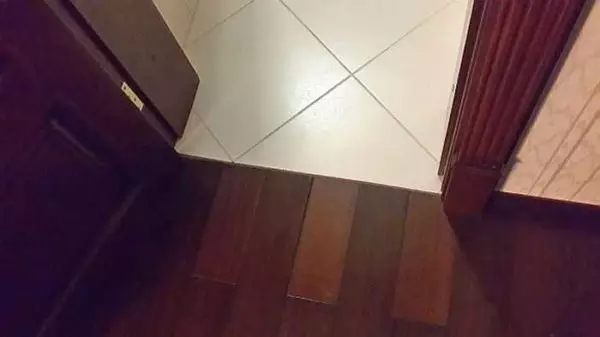
From the height of growth is not even visible than the seam is filled
- We are waiting for drying. This process depends on the thickness of the seam and temperature. It usually takes from 24 to 48 hours.
- Immediately after the alignment, we remove the painting tape with the remnants of the sealant. If it is somewhere on the floor, we clean the damp rag until the dough. Tool my water.
After drying, we have ready to use tile and laminate butt. The only drawback is not all suitable for the base color. And yet - it is necessary to carefully and smoothly distribute it immediately after applying. Then align or fix it will not work.
Using browses
Making a junction of laminate and tiles using thresholds makes sense in three cases. The first when the joke is obtained under the door. In this case, the presence of the thoring is logical and "does not cut the eye." The second option - in the presence of the height of two jammed materials. There is just no other way out.
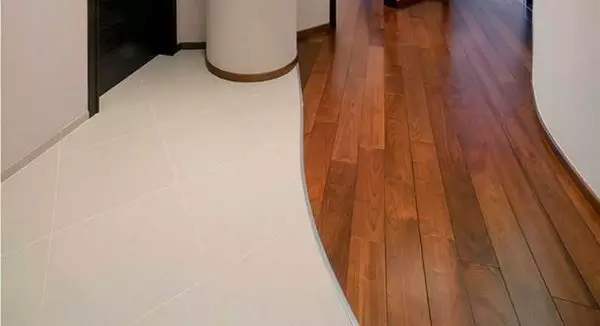
Do not seem to you that such a junction spoils the impression?
And the third case. When a tile is laid out in the hallway near the entrance door, and then laminate goes. Even if their level coincides, it is better to put the threshings here. He rises a bit above the finish and will delay the sand and litter, which is inevitably entered with shoes. This option is when some aesthetic imperfections can be closed.
Types of materials for the joint of materials
There are the following thresholds that can be used to close the junction of laminate and tiles:
- Flexible PVC profile. Consists of a base and an overhead decorative plank. The base is fastened to the floor in the seam, and the decorative bar is snapped. It happens in two types - for the joint of the materials of the same thickness (maximum drop 1 mm) and for connections from differentials (the difference can be 8-9 mm).
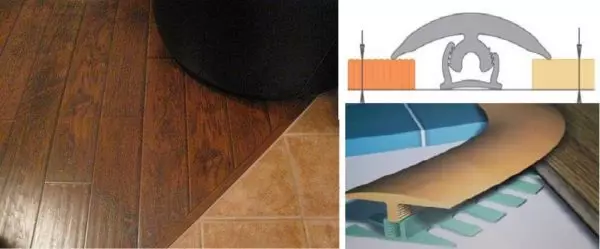
Using PVC profile for seam design between tiles and laminate
- Flexible metal profile. Nuts due to the elasticity of the metal (alloy) and a special curly edge. Used both for direct and curved areas. May have a T-shaped and M-shaped form. In the case of using a M-shaped profile, it is filled with laminate. The tile is then glued close to the edge, filling the distance with tiled glue, subsequently decorated with grouting for seams. There are flexible metal thresholds unscreased - aluminum, there is a decorative color (powder composition).
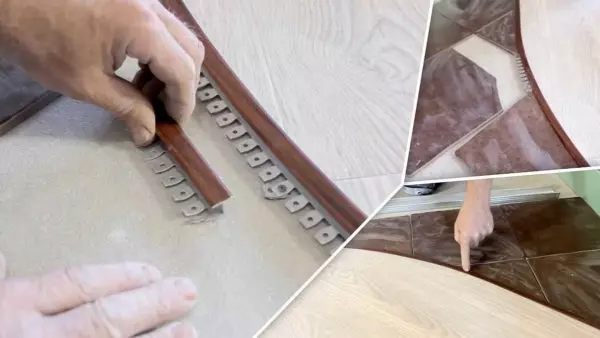
How to make a tile transition to laminate
- Aluminum threshing. Used for direct junction. Ideal for decoring the connection site under the door. It happens in the form of a T-shaped or n-shaped profile. The width of the "shelves" and the height of the very skin itself, the bending radius of the back - all this varies. In such thresholds, openings are usually drilled through which they are attached to the base with the help of dowels or self-tapping. There are still self-adhesive - this is the easiest installation option. When installing, so that dust and dirt and dirt will be clogged under the threshold, it can be woven with a sealant from the reverse side. After installing the surplus, remove and wipe it clean.
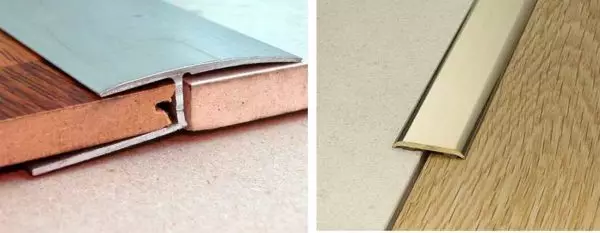
Aluminum thresholds are used in direct areas
It only seems that there are few options. There are all these bellows in different sizes and colors, with various fixation systems. In large stores there are a lot of them.
Installation of flexible PVC profile
As already spoke, the flexible docking profile PVC consists of a base and a decorative lining, which keeps on it due to the force of elasticity. It is necessary to mount it after the tile is laid, but before mounting the laminate.
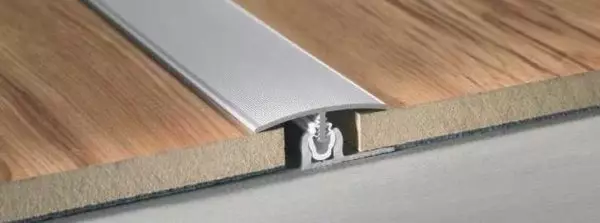
This is the case of the connection in the context
First, the base is mounted along the cut-off tile. It is attached to a dowel or self-tapping screw. Fasteners Choose with flat caps - so that in the twisted state it almost did not speak and did not interfere install the lining.
Installation process is:
- The base of the flexible PVC profile is laid out along the edge of the tile. His top edge should be in the surface of the finish. If necessary, you can cut off the strip of the substrate under the laminate.
- The base is attached to the floor.
- If you need to install the dowels, the fasteners installation points are placed, the profile is removed, the holes are driven, plastic tabs are installed. After that, it is possible to screw the base.
- When using screws, it may be necessary to predict (depends on the type of base). The step of installation of the fastener depends on the degree of curvature of the joint. The base of the docking profile should immediately repeat its outlines.
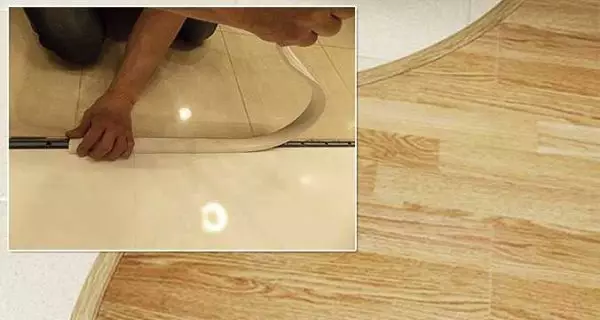
When installing PVC tapes have to make serious efforts
- Further laminate.
- Laminate is laminated, now in the established base with the effort to refuel the decorative PVC overlay. She is elastic and does not fit very well in the groove. It is necessary to put pressure well with the palm, you can even catch a rubber image.
With the help of flexible PVC profile, the shake of laminate and tiles are embossed. Externally, of course, he doesn't like everyone, but the installation is simple.
Mounting video installation at the junction of laminate and tiles / porcelain stoneware
Article on the topic: Wooden doors: how to make a tree
